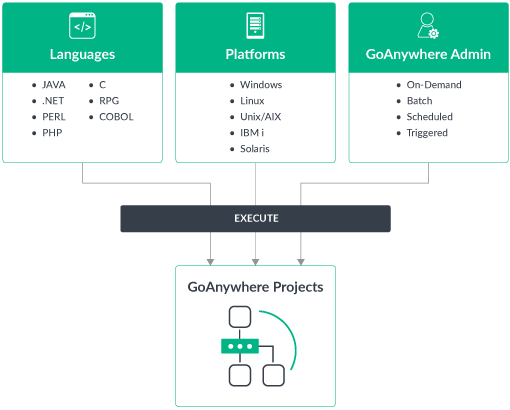Generic Systems Australia
File Transfer Automation
What is file transfer automation and how can it benefit your business? Explore this attractive solution for data movement, scheduling, and processing problems.
Automate Your File Transfers
File transfer automation allows you to manage recurring or high-volume file transfers, all while reducing or eliminating manual data processing.
Many organizations today still have tedious file transfer processes, copmlicated system setups, or manually transfer large files and bulk batches regularly. Automation simplifies and streamlines these everyday tasks; not only can it help reduce human error, it can save time and cut costs.
If you’re looking for file transfer automation software to help support your automation goals, you’ve come to the right place! Forget scripts, homegrown processes, and legacy PC tools. Automatic file transfer software, like GoAnywhere MFT allows its users to effortlessly configure when files should move between internal systems, other users, or trading partners.
How Does File Transfer Automation Work?

Automation involves using electronics or computer-controlled devices to have each step of a process run one after the next without human intervention. File transfer automation is the use of technology to monitor and control file movements, including sending, retrieving, and delivering data.
File transfer automation solutions help you make processes more efficient. With automatic file transfer, you can schedule when files should be sent or retrieved between systems, users, trading partners, applications, or the cloud. Automation is often used to manage recurrent file transfers, especially for high volumes of transfers.
File transfer automation can be more than just a file moving tool. Some solutions can monitor folders both on-premises or in the cloud, send you emails and SMS alerts when triggered events occur, and test and debug your automatic file transfer workflows.
Benefits of File Transfer Automation
When you automate file transfers, you can choose when files move between systems internally, between users, and trading partners, either by scheduling file transfers or setting up “triggers” that set off data movements once a specified event occurs.
Why use file transfer automation?
- Cost reduction: File transfer automation software can be a more cost-effective way to manage tedious tasks or work through lengthy file transfers.
- Productivity: As organizations grow, file transfer needs grow along with them. Automating your file transfers can save valuable time by eliminating lag time between file transfers and reducing human error; rather than allowing the computer to idle while waiting for an operator to release file transfer jobs, minimize operator intervention and allow files to move on a schedule.
- Availability: High availability reduces the risks posed by online system outages, and automation further shores your organization up against risks by automating your save and recovery systems. This helps ensure protection from potential data losses, down file transfer systems, or damages due to human error. Plus, continuous monitoring with a low CPU makes it easier to spot network performance trends.
- Reliability: Reliability is the cornerstone of any good IT operations department. Without it, you are bound to end up with confusion, chaos, and unhappy users. Automated operations ensure that jobs are not forgotten or run out of sequence. Prerequisite jobs are completed successfully, input data is correct, and any special processing is consistently performed. The ability to be reliable upon automation without fail is a strong benefit.
- Risk reduction: Set and forget the tasks you automate, and never worry about a missed step or other common human errors. And alleviating the need for human intervention can also help avoid unauthorized access and other data breaches.
- Security: Automating the data exchange process can not only help accelerate and streamline the process of transfer data, it can also elevate the level of security around it as the risk of human error is greatly reduced. Organizations with strong data security look at each data transfer event and thoughtfully apply policies – encryption, audit, validation of the user, validation of the recipient, redaction, etc. The beauty of this approach is that the employees do not have to handle any of that activity, so work gets done quickly, efficiently, and securely.
- Compliance: The policies around data security are more specific if an organization is regulated, such as healthcare, finance, transportation, and others. These industries must meet compliance requirements for GDPR, GLBA, HIPAA, PCI DSS, SOX, FISMA, and more. Not adhering to the specific security requirements for handling data at the various stages in its journey can lead to hefty fines and/or sanctions.
Once an automation schema is established, your file transfer automation solution can execute the workflows for transfers precisely and in the correct sequence, helping to eliminate human errors. Being able to forecast file transfer completion and having the ability to quickly resume file transfers or troubleshoot failed transfers can eliminate an abundance of the guesswork from daily tasks.
Types of File Transfer Automation Features
File transfer automation often includes features built to simplify your day to day. These features will execute in the background, track their own movements, and begin and end processes based on triggers that you identify ahead of time.
Automated scheduling: Using either a built-in scheduler or by connecting your existing scheduler software, you can choose when processes kick off.
Automated workflows: Automating your projects and running workflows back to back is essential to file transfer automation. Quickly build workflows and combine both manual and automated tasks into one master workflow.
Automate data movements across the board: Send data securely with automated file transfer software.
Automating Large File Transfers
Without the right solution, transferring large files can trip up even the most seamless file transfer process. Organizations that need to routinely share and send large files, or large batches of files, frequently turn to file transfer automation as a solution. By using a file transfer workflow, you can streamline your processes from beginning to end and rest assured that your data will be encrypted, tracked via audit and activity logs, and delivered successfully to the recipient.
When choosing a method for automating your large file transfers, some features to look for include:
- Unlimited file size transfers and volume capacities
- Built-in schedulers
- Functionality for batch file automation
- Secure email capabilities
- Auto-resume
- Audit logs and reporting
- Speed of file transfers
Overall, file transfer automation is proven to reduce the time admins spend on large file transfers for the enterprise, freeing up room to work on other projects.
About GoAnywhere MFT
Secure file transfer is important for every organization. Juggling multiple tools and utilizing manual methods will always slow down operations. GoAnywhere Managed File Transfer (MFT) is a robust solution that automates and manages file transfers using modern data security standards. It’s a good feeling knowing that files at rest and in motion are protected against ill-intentioned parties. Regardless of file size and volume, GoAnywhere MFT reconnects and resumes file transfers and notifies you via email or text alerts of transfer statuses.
Automation is Key

File transfer automation software is a powerful tool to have in your toolbelt. As a secure FTP automation software solution, GoAnywhere MFT lets users quickly automate file transfers and schedule projects to run using its built-in scheduler or any existing scheduler software. Built-in scheduling allows for executing workflows at future dates and times. You can schedule workflows as “one time” or to run every minute, every hour, or every day – whatever or whenever your preference.
Calendars can even be easily customized to ensure workflows don’t run on days they shouldn’t. Workflows (Projects) can also be automated, executing whenever a file monitor detects new, modified, or deleted files in targeted folders. The file monitor can also alert you if an error occurs during the process, such as a file failing to reach its intended location. Goodbye manual work, hello simplicity!
Workflows can be called from local and remote command lines, scripts, and programs using the provided commands and APIs. They can additionally be called as Web Services using SOAP or REST requests. To execute Workflows based on user activity, triggers can monitor for events like when a file is uploaded or downloaded. Setting a trigger allows you to set in motion a sequence of actions prompted by an event. Triggers eliminate the time-consuming process of manually completing routine follow-up tasks.
Executing Workflow and File Automation Projects in GoAnywhere
Users can achieve workflow and file automation with a single click within GoAnywhere’s browser-based administrator. GoAnywhere MFT can not only execute multiple projects with its job management system, administrators can define multiple job queries to group projects that share common characteristics or service level agreements (SLAs).
Each job queue can define the priority of their jobs, as well as the maximum number of concurrent jobs that can be executed from the queue. Job queues can be managed and prioritized through GoAnywhere's Administrator interface.
Workflows can also be executed in Debug mode, which allows users to interactively execute tasks one step at a time. At each stopping point, the values for the variables can be viewed or changed before the next task is executed.
Don't Wait – Automate!
With GoAnywhere MFT’s free license, you’ll be able to do just that with the FTP client module. The free license also includes an FTP Server, 5 Secure Mail accounts, and 5 GoDrive users. The free license is perfect for small organizations who don’t exchange sensitive files or need to comply with data security regulations. Start the free trial and you’ll receive email instructions on how to get started.
Remote Automation Solutions with GoAnywhere Agents
MFT agents are lightweight applications that allow administrators to remotely control automated file transfers and file processing from a central GoAnywhere server. Agents can be installed virtually anywhere, such as servers and desktops located on-premises, external systems like retail locations or trading partners, or even in the cloud.

Install Agents Anywhere
Agents can be installed onto almost any server or workstation where file transfers or workflows need to be performed. These systems can reside on-premises or in cloud infrastructure.
- Windows
- Linux
- IBM i
- Mac OS
- Azure
- Amazon EC2
Agent Maps
Agents can be monitored and managed via an interactive map. Agents are color coded to indicate if they are online or offline. Simply click on a pin location to launch the Agent console. Agent maps allow you to:
- See your worldwide agent deployment anytime, anywhere.
- View the agent console from the central GoAnywhere server.
- Edit and process agents grouped in the same location.